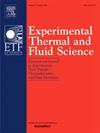Aerodynamic flame stabilization at sub-limit global equivalence ratio, exploiting high velocity ratio coaxial jets: An experimental approach
IF 2.8
2区 工程技术
Q2 ENGINEERING, MECHANICAL
Experimental Thermal and Fluid Science
Pub Date : 2025-04-26
DOI:10.1016/j.expthermflusci.2025.111504
引用次数: 0
Abstract
This work investigates the flow and flame stabilization characteristics of a novel partially premixed aerodynamic flame stabilization configuration. Flames are established in the interaction region of high velocity ratio coaxial jets, at the location where the local flame speed and the reacting flow velocity match. The isothermal flow and mixing field characteristics are first experimentally investigated at four velocity ratios, ranging from 5 to 9, to delineate the operating conditions that promote the formation of a centrally located recirculation region. Combined with a suitable and freely adjustable fuel injection methodology, that supplies the reacting region with a locally flammable mixture, an inverted bowl-shaped flame is aerodynamically established, at sub-limit global equivalence ratio values, with ignition. These flames have no fixed edge anchoring point and remain relatively stationary throughout the investigated load variations, suffering no heat losses to the burner. Particle Image Velocimetry, Fourier Transform Infrared Spectroscopy, Mie scattering and OH* Chemiluminescence measurements have been conducted to investigate the flow and mixing characteristics, flame topology and turbulence effects as well as displacement speed correlations with turbulence intensity. Results indicated that the flame brush location and topology are demarcated by the flame induced accelerating region and maximum OH* chemiluminescence intensity with local Damköhler () and Karlovitz () numbers suggesting that flame stability is primarily governed by reaction kinetics rather than turbulence effects. Finally, the local displacement speeds revealed a lineal correlation with the fluctuating velocities, for the flame configurations studied, highlighting characteristic resemblances with the typical low-swirl burner setup.
利用高速比同轴射流的亚极限等效比气动火焰稳定:实验方法
本文研究了一种新型部分预混气动稳焰结构的流动和稳焰特性。火焰是在高速比同轴射流相互作用区域内,在局部火焰速度与反应流速度匹配的位置上产生的。首先对等温流动和混合场特性进行了实验研究,在4种速度比下,范围从5到9,以描绘促进中心位置再循环区域形成的操作条件。结合一种合适的、可自由调节的燃油喷射方法,为反应区域提供局部可燃混合物,在亚极限的全局等效比值下,在空气动力学上建立了一个倒置的碗形火焰,并点火。这些火焰没有固定的边缘锚点,在整个负载变化过程中保持相对静止,没有热量损失到燃烧器。通过粒子图像测速、傅里叶变换红外光谱、Mie散射和OH*化学发光测量,研究了火焰的流动和混合特性、火焰拓扑结构和湍流效应以及位移速度与湍流强度的相关性。结果表明,火焰刷的位置和拓扑结构以火焰诱导加速区和最大OH*化学发光强度为界,其局部值为Damköhler (Da)和Karlovitz (Ka),表明火焰稳定性主要受反应动力学而非湍流效应的影响。最后,对于所研究的火焰配置,局部位移速度与波动速度呈线性相关,突出了与典型低旋流燃烧器设置的特征相似性。
本文章由计算机程序翻译,如有差异,请以英文原文为准。
求助全文
约1分钟内获得全文
求助全文
来源期刊

Experimental Thermal and Fluid Science
工程技术-工程:机械
CiteScore
6.70
自引率
3.10%
发文量
159
审稿时长
34 days
期刊介绍:
Experimental Thermal and Fluid Science provides a forum for research emphasizing experimental work that enhances fundamental understanding of heat transfer, thermodynamics, and fluid mechanics. In addition to the principal areas of research, the journal covers research results in related fields, including combined heat and mass transfer, flows with phase transition, micro- and nano-scale systems, multiphase flow, combustion, radiative transfer, porous media, cryogenics, turbulence, and novel experimental techniques.
 求助内容:
求助内容: 应助结果提醒方式:
应助结果提醒方式:


